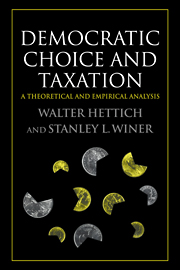Book contents
- Frontmatter
- Contents
- Preface
- 1 Introduction
- PART ONE THEORETICAL FRAMEWORK
- 2 Models of Political Economy and the Study of Taxation
- 3 Foundations of Democratic Tax Systems
- 4 Tax Structure in Equilibrium: A More Formal Model
- PART TWO COLLECTIVE CHOICE AND THE NORMATIVE ANALYSIS OF TAXATION
- PART THREE APPLIED GENERAL EQUILIBRIUM ANALYSIS
- PART FOUR STATISTICAL ANALYSIS OF TAX STRUCTURE
- PART FIVE POLITICAL INSTITUTIONS AND TAXATION
- Bibliography
- Name Index
- Subject Index
4 - Tax Structure in Equilibrium: A More Formal Model
Published online by Cambridge University Press: 08 October 2009
- Frontmatter
- Contents
- Preface
- 1 Introduction
- PART ONE THEORETICAL FRAMEWORK
- 2 Models of Political Economy and the Study of Taxation
- 3 Foundations of Democratic Tax Systems
- 4 Tax Structure in Equilibrium: A More Formal Model
- PART TWO COLLECTIVE CHOICE AND THE NORMATIVE ANALYSIS OF TAXATION
- PART THREE APPLIED GENERAL EQUILIBRIUM ANALYSIS
- PART FOUR STATISTICAL ANALYSIS OF TAX STRUCTURE
- PART FIVE POLITICAL INSTITUTIONS AND TAXATION
- Bibliography
- Name Index
- Subject Index
Summary
The power to make distinctions exists with full vigour in the field of taxation.
Stanley Reed (quoted by Yablon 1994)If we assume that tax decisions are made by simple majority, the problem becomes a different one from Wicksell's.
Eric Lindahl (1959, p. 17)In the preceding chapter we argued that multiple tax bases, separate rate structures, and a variety of special provisions can be understood as a set of related policy instruments that are shaped and used by the government in the course of its continuing struggle to maintain itself in elected office. In this chapter we explore this idea further, using a model that is more formal than the one presented in Chapter3. The model is also more detailed with respect to individual behavior, allowing for the possibility that voters may reduce their tax liabilities by “self-selecting” their level of work effort in order to alter their tax liabilities. Allowing taxpayers to mimic the behavior of others who face lower tax rates is a way of acknowledging that some characteristics of taxpayers that would be a useful basis for taxation, such as potential work effort or intellectual ability, cannot be directly observed by tax collectors. This means that the government must levy taxes according to surrogate characteristics that are correlated with the basis upon which it would prefer to impose taxes, while allowing for the fact that taxpayers may choose to misrepresent themselves in response to taxation based on these surrogate characteristics.
- Type
- Chapter
- Information
- Democratic Choice and TaxationA Theoretical and Empirical Analysis, pp. 61 - 96Publisher: Cambridge University PressPrint publication year: 1999



